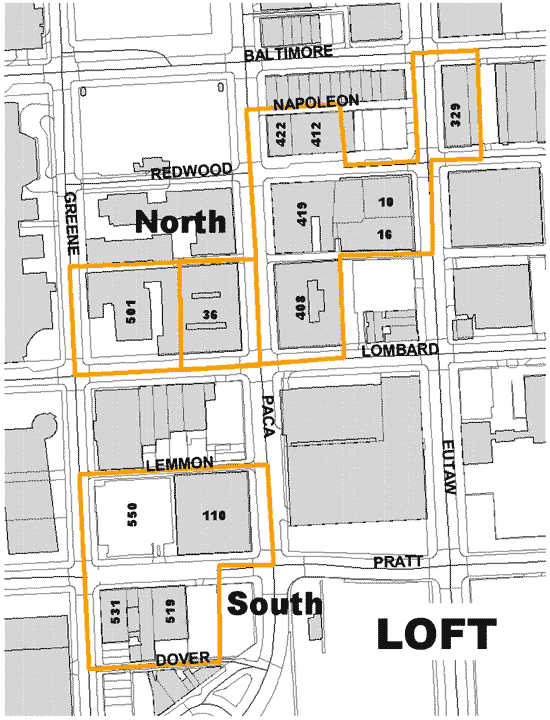Loft
Baltimore City Historic District Ordinance 715 5/12/78
Loft District (North) National Register Historic District 1/3/85
Loft District (South) National Register Historic District 1/3/85
Certified Historic District for Tax Incentives (NR)
Description
 Two National Register Historic Districts, known as Loft District (North) and Loft District (South), include nineteen brick manufacturing buildings near the University of Maryland Campus in downtown Baltimore. Most of the buildings are still used for manufacturing purposes, although a few have been converted into loft apartments or offices. These late nineteenth to early twentieth century vertical manufactories are stylistically representative of Romanesque, Victorian and early modern industrial architectural design.
Two National Register Historic Districts, known as Loft District (North) and Loft District (South), include nineteen brick manufacturing buildings near the University of Maryland Campus in downtown Baltimore. Most of the buildings are still used for manufacturing purposes, although a few have been converted into loft apartments or offices. These late nineteenth to early twentieth century vertical manufactories are stylistically representative of Romanesque, Victorian and early modern industrial architectural design.
Most of the buildings are from five to seven stories in height. They feature a variety of architectural details including: decorative brick work, cast iron storefronts, terra cotta decoration, classical detailing and rooftop water tanks. Only minor alterations have taken place to the buildings, and there is a high degree of integrity within the area. This area retains the largest concentration of loft type structures and the finest industrial streetscapes in downtown Baltimore. The Baltimore City Loft Historic District takes in one loft grouping now known as the Inner Harbor Loft Apartments and four University of Maryland Buildings, most notably David Hall.
Significance
The Loft District area is architecturally significant for its excellent, massive, brick vertical manufactories, which date from 1870-1915 and represent the finest collection of large, Victorian, Romanesque and Neo-Classical early modern industrial design in Baltimore. They are the works of important local architects including George Frederick, Simonson and Pietsch, Parker and Thomas, Charles L. Carson and Charles Cassell. The buildings are noteworthy as local adaptations of industrial designs in other American cities by such noteworthy nationally important architects as H.H. Richardson and Henry L. Sullivan.
Many have fine architectural features such as cast iron storefronts that are among the best examples of this building element in Baltimore City. Historically, this area housed some of Baltimore's leading industrial firms, especially clothing manufacturers. It as in this areas that Baltimore's garment industry grew to national importance. The district takes in some of the most notable firms of late nineteenth century Baltimore industry including E. Rosenfeld & Company, Hamburger Brothers, Brigham Hopkins Company, Sonneborn & Company, Strauss Brothers and M.S. Levy & Sons. The district is also associated with the important people who owned and ran these companies. These individuals were among Baltimore's business, civic and social leaders that helped to guide the City's development in the late nineteenth and early twentieth centuries.